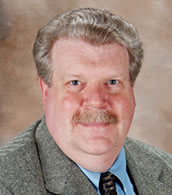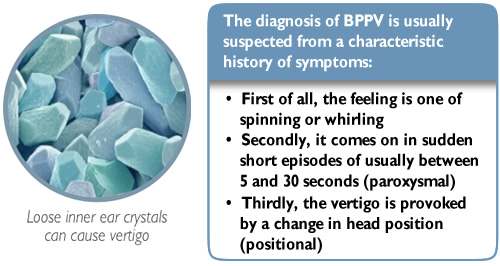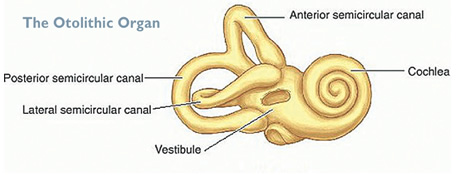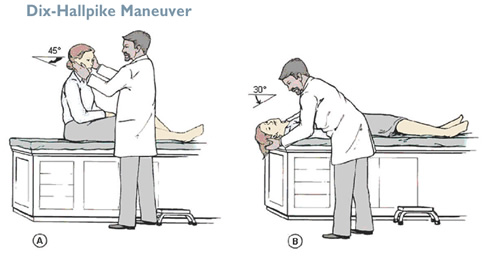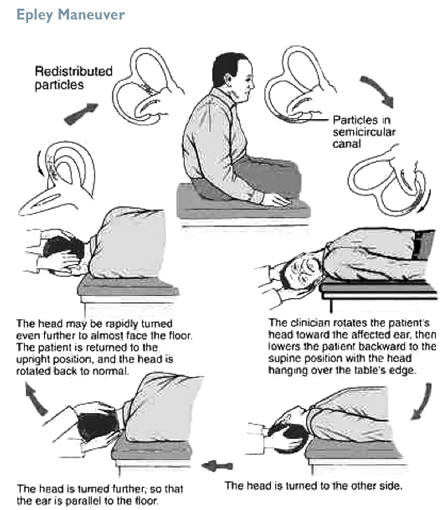|
Benign Paroxysmal Positional VertigoRichard Crane, MD, FACS Dizziness is a common condition. Vertigo should be reserved for describing dizziness when there is a strong sense of whirling or spinning. Only half the cases of dizziness are caused by an ear problem, which is usually felt as “spinning” vertigo. Other common reasons for dizziness include: central nervous system, migraine headache, heart and circulation, blood pressure, metabolic, hormonal and nutritional problems. The most common form of ear-related dizziness is called Benign Paroxysmal Positional Vertigo (BPPV).
The balance organ of the inner ear is called the “labyrinth”. The labyrinth is filled with fluid and has two parts: the vestibule and the semicircular canals (three canals in each ear). Within each vestibule there are “otolithic” organs (oto = ear, lithic = stones). These otolithic organs are a “carpet” of many tiny nerve endings, covered with a sticky material, with thousands of microscopic otolithic crystals of calcium carbonate (limestone) attached. These organs are “gravity sensitive”. The crystals are pulled down by gravity sending information through the nerves to the brain as to which way is “up”. The semicircular (half-circle) canals have nerves in them too, but no crystals. They are designed to tell us we are turning or spinning, as the fluid in the canals “sloshes” around with rotational movements of our head and body.
Benign paroxysmal positional vertigo (BPPV) occurs when several dozen or more otolithic crystals become detached from the nerve “carpet”, and accidentally end up in one of the semicircular canals. This can happen from a blow to the head, a viral infection of the inner ear, aging or often times for no obvious reason. These otolithic crystals will cause the semicircular canal to become abnormally sensitive to gravity. So when you tilt your head in just the right (or wrong!) way, the crystals will move the fluid as they settle by gravity, and the fluid will move the nerve endings, which will send a signal to your brain that you are turning or spinning. The vertigo will stop after 5 to 30 seconds, when the crystals reach the lowest point along the curve of the half-circle canal. Typically the change in position is tilting the head back, or when lying down or rolling from side to side in bed. Dizziness that occurs when sitting up or standing up is “positional” to be sure, but should more properly be termed “orthostatic postural dizziness”, and is almost never BPPV. Dizziness that is not vertigo (not spinning), that lasts longer than one minute, that is associated with any other symptoms (such as hearing loss, tinnitus, headache, limb or facial weakness, or fainting), is almost certainly not BPPV. The diagnosis of BPPV is confirmed by performing the Dix-Hallpike positioning maneuvers, where the patient is laid back with the head turned, and the eyes are watched for characteristic jerky movements known as “nystagmus”. The experienced physician, by observing the nystagmus, can usually determine which canal in the right or left ear is causing the problem. Infrequently, two or even three canals can contain the loose crystals, or the crystals can move from one canal to another during the course of treatment.
Treatment of BPPV has changed over the years. In many cases, spontaneous remission of the BPPV will unpredictably occur after weeks or months. Decades ago the patient was advised they would have to learn to live with it, and were told “if you get dizzy when you do that, then don’t do that”. Often motion sickness medications are prescribed, such as Meclizine or Valium, but they rarely completely relieve the strong sensation of vertigo, and do nothing to correct the problem. We then entered a period of prescribing “habituation exercises”. The patient was taught to repeatedly assume the position that provoked the vertigo to habituate or “train” the brain to ignore the abnormal nerve signal from the semicircular canal. This treatment was helpful in some cases, but it is possible those who were “cured” may have actually experienced spontaneous remission. About twenty years ago, particle repositioning maneuvers (PRMs) were introduced. The PRM treatment is performed by moving the patient’s head and body in a specific sequence of positions calculated to move the crystals back into the vestibule where they will hopefully reattach to the “glue” on the otolithic organ. This form of treatment was pioneered in 1980 by an American otologist (ear specialist), Dr. John Epley, and his audiologist colleague, Dr. Dominic Hughes. Their simple and innovative PRM maneuvers were initially met with disbelief, and ridiculed by the medical establishment until 1992. Drs. Epley and Hughes were vindicated by their success. The PRMs are often referred to collectively as “the Epley Maneuver”. It must be understood, however, that there are six semicircular canals (three in each ear), and there is a specific sequence of positions to properly treat each canal. Therefore there are actually six different PRMs. The treating clinician should be experienced in BPPV diagnosis and nystagmus interpretation, to be able to apply the correct PRM or “Epley maneuver” for each patient. When properly performed, the PRM will resolve 80 – 90% of BPPV cases in one or two treatments.
Dr. Richard Crane–Southside OB-GYN |
